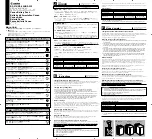
•
3
•
IMPORTANT SAFETY INSTRUCTIONS
WARNING – RISK OF EXPLOSIVE GASES
WORKING IN THE VICINITY OF A LEAD-ACID BATTERY IS DANGEROUS. BATTERIES
GENERATE EXPLOSIVE GASES DURING NORMAL OPERATION. FOR THIS REASON,
IT IS IMPORTANT THAT YOU FOLLOW THESE INSTRUCTIONS EACH TIME YOU USE
THE CHARGER.
To reduce the risk of a battery explosion, follow these instructions and those published
by the manufacturer of the battery and any equipment you intend to use in the vicinity
of the battery. Review the cautionary markings on these products and on the engine.
WARNING:
Pursuant to California Proposition
65, this product contains chemicals known to
the state of California to cause cancer and
birth defects or other reproductive harm.
Wash hands after handling.
•
Keep out of reach of children.
•
Use the battery charger on LEAD-ACID and
AGM-type rechargeable batteries with
recommended rated capacities of 24 Ah
(6V) and 44-75Ah (12V), as used in
automobiles, trucks, tractors, airplanes,
vans, RVs, trolling motors, etc. This charger
is not intended to supply power to low-
voltage electrical systems, other than in a
motor-starting application.
WARNING:
Do not use battery charger with
dry cell batteries that are commonly used with
home appliances. These batteries may burst
and cause injury or damage to property.
•
Use only attachments recommended or sold
by the battery charger’s manufacturer. Use
of non-recommended attachments may
result in a fire, electric shock or injury.
•
Locate the battery charger’s power cord so
it cannot be stepped on, tripped over, or
subjected to damage or stress.
•
Do not operate the charger if it has received
a sharp blow, been dropped, or otherwise
damaged in any way. Take it to a qualified
professional for inspection and repair.
•
Do not disassemble the charger. Take it to a
qualified professional when service or repair
is required.
•
To reduce the risk of electric shock, unplug
the charger from the outlet before
attempting any maintenance or cleaning.
•
Do not use an extension cord.
•
Always charge the battery in a well-
ventilated area.
•
Do not set the charger on flammable
materials, such as carpeting, upholstery,
paper, cardboard, etc.
•
NEVER
smoke or allow sparks or flames in
the vicinity of the battery or engine.
WARNING: RISK OF EXPLOSIVE GAS.
•
Operate the charger as far away from the
battery as DC charger cables permit.
•
Do not expose the charger to rain or snow.
•
NEVER charge a frozen battery.
•
NEVER set a battery on top of the charger.
•
NEVER place the charger directly above a
battery being charged. Gases from the
battery will corrode and damage the charger.
•
NEVER touch the battery clamps together
when the charger is energized.
•
When disconnecting the battery charger, pull
by the plug, not by the cord. Pulling on the
cord may cause damage to the cord or plug.
•
Do not operate the charger with a damaged
cord or plug.
•
NEVER allow battery acid to drip onto the
charger.
•
NEVER overcharge a battery.
PERSONAL SAFETY PRECAUTIONS
•
Wear complete eye protection and
protective clothing when working near
lead-acid batteries. Always have someone
nearby for help.
•
Have plenty of fresh water, soap and baking
soda nearby for use, in case battery acid
contacts your eyes, skin, or clothing. Wash
immediately with soap and water and seek
medical attention.
•
If battery acid comes in contact with eyes,
flush eyes immediately for a minimum 10
minutes and get medical attention.
•
Neutralize any acid spills thoroughly with
baking soda before attempting to clean up.
•
Remove all personal metal items from your
body, such as rings, bracelets, necklaces
and watches. A battery can produce a short
circuit current high enough to weld a ring to
metal, causing a severe burn.
•
Do not drop a metal tool onto the battery.
•
If it is necessary to remove the battery from
the vehicle to charge it, always remove the
grounded terminal first.




































